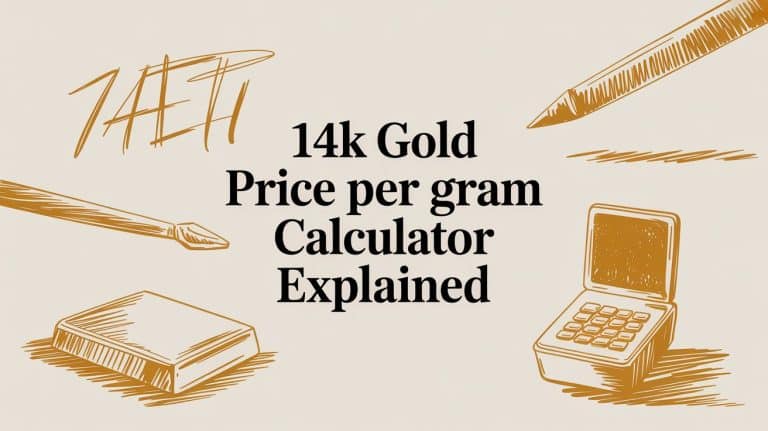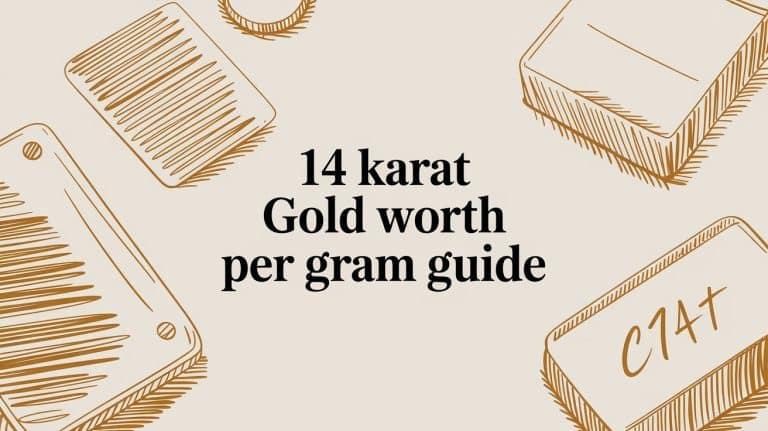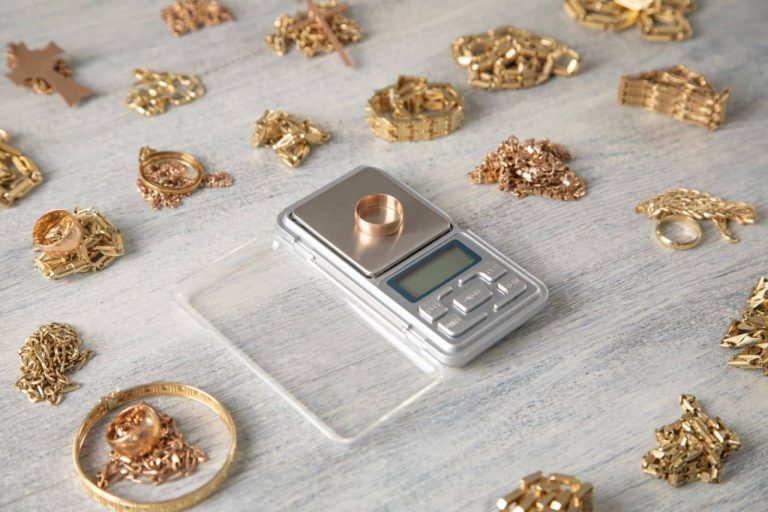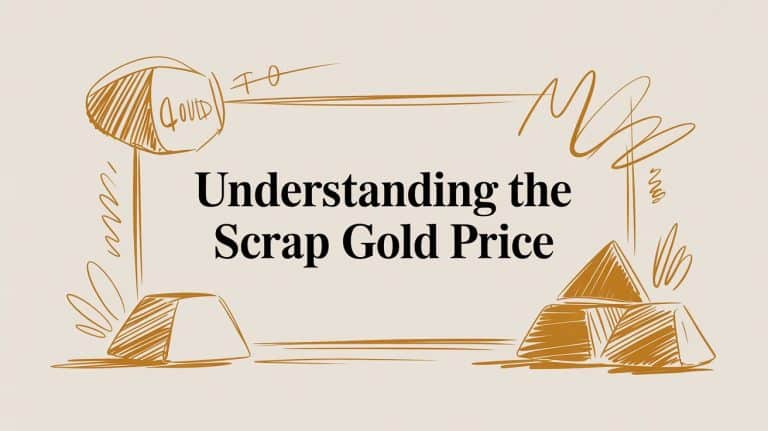Using a Gold Scrap Value Calculator Accurately
Ever wondered what that tangled chain or single earring sitting in your jewelry box is actually worth? A gold scrap value calculator is the quickest way to find out. It’s a simple online tool that gives you a solid estimate of your unwanted or broken gold’s melt value.
These calculators cut through the noise by using three key pieces of information purity, weight, and the live market price of gold to tell you what your items are worth based purely on the gold they contain.
How a Gold Scrap Value Calculator Really Works

Think of a gold scrap calculator as your personal financial tool for precious metals, but one that’s incredibly easy to use. Its entire purpose is to simplify the complex global gold market and give you a straight up number. Instead of you having to track fluctuating prices or wrestle with complicated math, the calculator does all the heavy lifting.
To work its magic, the tool needs three critical inputs from you. Each one is a vital ingredient in the valuation recipe; get one wrong, and the final number will be off.
The Essential Inputs for an Accurate Estimate
First up is your gold’s purity. This is measured in karats like 10K, 14K, or 18K and tells the calculator how much pure gold is in your item versus other metals. It’s simple: a higher karat means a higher percentage of pure gold and, naturally, a higher value.
Next, the calculator needs the weight of your items. Accuracy is everything here, which is why a precise digital scale is a must. You can enter the weight in different units like grams, pennyweights (dwt), or troy ounces, and the tool will handle the conversions for you.
Finally, there’s the most dynamic piece of the puzzle: the live spot price of gold. This is the current market rate for pure, 24K gold, and it changes constantly throughout the day based on global trading. A good calculator pulls this data in real time to make sure your estimate is based on the most current market conditions.
An accurate gold scrap value calculator combines these three inputs purity, weight, and the live spot price to provide a transparent and immediate baseline for what your gold is worth.
Putting It All Together
Once you plug in these details, the calculator runs a simple but powerful calculation. It figures out the exact amount of pure gold in your items based on their weight and purity, then multiplies that amount by the current spot price. The result is the gross melt value of your scrap gold. If you want to dive deeper into how different factors can affect the final number, you can explore a detailed guide on scrap gold price.
This process strips away all the guesswork. It arms you with a data driven starting point for any negotiation with a buyer. By understanding exactly how the calculator works, you can feel confident in the numbers it gives you. This sets the stage for a deeper look at each factor, which we’ll get into next.
Understanding the Four Pillars of Gold Valuation
To really get a handle on what a gold scrap calculator is telling you, it helps to know what’s going on behind the scenes. Think of it like a chef’s recipe the final dish is only as good as the ingredients. Gold valuation is pretty much the same and boils down to four key pillars that work together to give you an accurate number.
Once you grasp these core components, the calculator stops being a mysterious black box and becomes a transparent, useful tool. This knowledge is what empowers you to see your gold’s true potential and sell it with confidence.
Pillar 1: Gold Purity or Karat
The first, and maybe most important, pillar is your gold’s purity, which we measure in karats. To get a better sense of this, you can explore the different types of gold karats and see how they change an item’s value.
The karat system is just a simple way to describe how much pure gold is in your item versus other metals like copper, silver, or zinc. Pure gold is 24 karat (24K), meaning it’s 100% the real deal. But 24K gold is incredibly soft, so other metals are usually mixed in to make it durable enough for jewelry.
Key Insight: The karat number is just a fraction out of 24. So, 14K gold means your item is made of 14 parts pure gold and 10 parts other metals.
Any good calculator has to know the karat of your gold to figure out the percentage of pure gold it contains. The higher the karat, the more your item is worth per gram. You can learn more in our deep dive guide on the difference between 14K, 18K, and 24K gold.
Pillar 2: Accurate Weight
The second pillar is the weight of your scrap gold. This sounds simple enough, but getting it right is absolutely critical. A kitchen scale might give you a ballpark figure, but it just doesn’t have the precision you need when every fraction of a gram counts.
Jewelers and professional gold buyers use highly accurate, calibrated digital scales to get a precise measurement. If you want the most accurate online calculation, you should try to do the same.
A solid gold scrap calculator will let you enter the weight in a few common units:
- Grams (g): The go to unit for weighing most scrap gold jewelry.
- Pennyweight (dwt): An older unit, equal to 1.555 grams, that some jewelers in North America still use.
- Troy Ounce (ozt): The standard for precious metals on the global markets, weighing in at 31.1 grams.
Pillar 3: The Live Gold Spot Price
Next up is the spot price of gold. This is the live, wholesale market price for one troy ounce of pure, 24K gold. It’s set by major commodity exchanges worldwide and is constantly changing based on the economy, supply and demand, and global events.
Think of the spot price as the baseline value for raw, unprocessed gold. A trustworthy calculator will pull this data in real time to make sure your estimate reflects the very latest market conditions. It’s the anchor for the whole valuation.
Pillar 4: The Buyer’s Margin
Finally, we have the fourth pillar the one people often forget about: the buyer’s margin. You might also hear it called a refiner’s fee. While a calculator gives you the gross melt value of your gold based on market prices, a buyer will offer you a percentage of that number.
This isn’t a scam; it’s just part of their business model. Buyers have costs for testing, melting, and refining the scrap gold back into its pure form. They also have to cover their overhead and turn a small profit. This margin usually means your final payout will be somewhere between 75% to 95% of the calculated spot value.
| Karat | Gold Purity | Common Items | Typical Buyer Payout (% of Spot Value) |
|---|---|---|---|
| 10K | 41.7% | Class rings, durable jewelry | 75% – 85% |
| 14K | 58.3% | Rings, chains, bracelets | 80% – 90% |
| 18K | 75.0% | High end jewelry, watches | 85% – 95% |
| 24K | 99.9% | Gold bars, bullion coins | 95% – 98% |
Understanding these four pillars purity, weight, spot price, and the buyer’s margin is the key to using a gold scrap value calculator effectively and having realistic expectations when you decide to sell.
The Simple Math Behind Your Gold’s Value
Wondering how a gold calculator comes up with its numbers? It’s not some complicated secret locked away in a vault. The truth is, the math is surprisingly simple, and it’s something anyone can do with a basic calculator.
At its heart, the calculation hinges on the three key factors we’ve been talking about: the weight of your item, its purity (or karat), and the live market price of gold. A good online calculator just automates this process for you.
The Core Formula for Gross Gold Value
To figure out the baseline value of your gold before a buyer takes out their fees, the formula follows a logical path. This is the exact calculation a scrap gold calculator uses to give you that initial estimate.
Here’s the formula:
(Gold Weight × Purity Percentage) × Current Gold Spot Price = Gross Scrap Gold Value
Let’s break that down. First, you take the total weight of your item and multiply it by its purity. This step is crucial because it tells you how much actual pure gold is in your piece. Then, you multiply that amount of pure gold by the current market price to get its total value. Simple as that.
The infographic below shows this three step process in action.
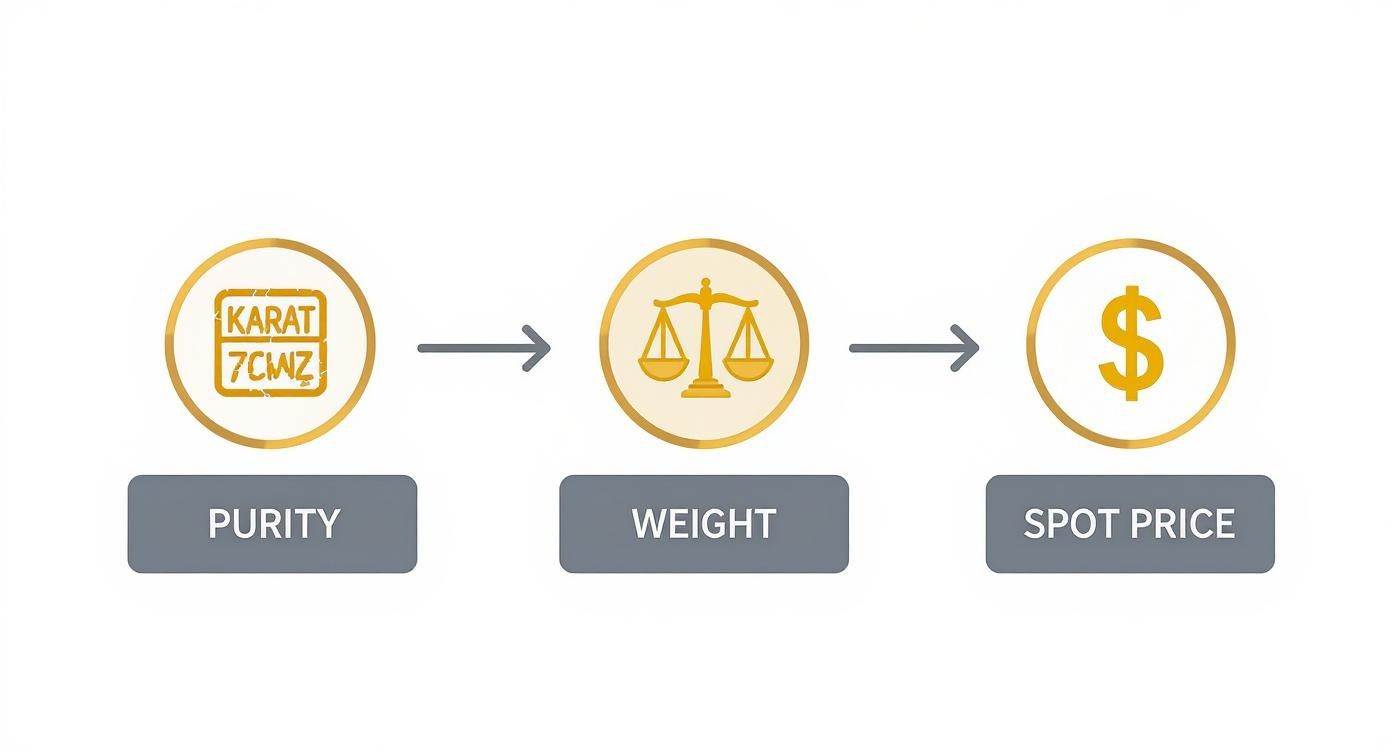
As you can see, it all flows together. You start with purity, add in the weight, and then apply the live market price. Each step builds on the last one to paint a complete picture of your gold’s worth.
A Real World Calculation Example
Theory is great, but let’s see how this works with a real item. We’ll use a common piece of jewelry: a 14K gold ring.
Imagine you have a 14K gold ring that weighs 5 grams on an accurate digital scale. You look up the live market data and see that the current gold spot price is $75 per gram for pure, 24K gold.
Here’s how you’d calculate its gross value, step by step:
Convert Karat to Purity Percentage: First, figure out the purity of 14K gold. Since pure gold is 24K, you just divide 14 by 24. That gives you 0.583, which is 58.3% pure gold.
Calculate the Pure Gold Weight: Next, multiply the ring’s total weight by that purity percentage. So, it’s 5 grams × 0.583 = 2.915 grams of pure gold. This means your 5 gram ring actually contains just under 3 grams of gold.
Determine the Gross Value: Finally, multiply the weight of the pure gold by the current spot price. That’s 2.915 grams × $75 per gram = $218.63.
So, the estimated gross scrap value of your 14K gold ring is $218.63. This is the number a gold scrap value calculator would give you before any buyer fees or refining costs are considered.
Understanding this process proves that a reliable calculator isn’t some “black box.” It’s just a transparent tool based on straightforward logic. Once you get how it works, you’ll have the confidence of knowing exactly where the numbers are coming from. To dive even deeper, check out our guide on the complete gold calculation formula.
Calculating Value for Common Scrap Gold Items
Theory is great, but putting it into practice is what really builds confidence. Now that you have a handle on the formula, let’s run through a few real world examples with a gold scrap value calculator. This is where you’ll see exactly how purity, weight, and the live spot price all come together.
To keep things simple and clear, we’ll use a consistent gold price for our examples. Let’s assume the live spot price for pure, 24K gold is $70 per gram.
Keep in mind, the numbers we come up with represent the gross melt value that’s the total value of the raw gold before a buyer or refiner deducts their fees. Think of it as the starting point for any negotiation, not the final check you’ll receive.
From a 14K Necklace to a Cash Estimate
Let’s start with one of the most common items out there: a 14K gold necklace. Because it’s a blend of 58.3% pure gold and other alloys, 14K offers a fantastic balance of rich color and everyday durability, making it perfect for chains, rings, and pendants.
Imagine you’ve got a tangled 14K gold chain that you never wear. You pop it onto a small digital scale and find it weighs exactly 15 grams.
Here’s how a gold scrap value calculator crunches those numbers:
Step 1: Find the Pure Gold Content. The first job is to figure out how much of that 15 grams is actual gold. The calculator multiplies the total weight by the purity: 15 grams × 0.583 = 8.745 grams of pure gold.
Step 2: Apply the Spot Price. Next, it takes that pure gold weight and multiplies it by our sample spot price: 8.745 grams × $70/gram = $612.15.
So, the estimated gross value of your 15 gram 14K necklace is $612.15. It’s that simple.
Valuing an 18K Bracelet in Pennyweights
Now for a slightly different scenario. Let’s look at a higher purity item and a different unit of measurement that some jewelers, especially in the U.S., still use: the pennyweight (dwt). One pennyweight equals 1.555 grams.
Let’s say you have an old 18K gold bracelet. At 75% pure gold, it has that richer, deeper yellow color you see in finer jewelry. You weigh it and it comes in at 8 pennyweights (dwt).
A good calculator will handle the unit conversion automatically, but here’s a look at the math working behind the scenes:
Convert to Grams: First, we need to get the weight into grams to keep our calculation standard. 8 dwt × 1.555 g/dwt = 12.44 grams.
Find the Pure Gold Weight: Now, we apply its 75% purity to find the actual gold content: 12.44 grams × 0.75 = 9.33 grams of pure gold.
Calculate the Gross Value: Finally, multiply by our spot price: 9.33 grams × $70/gram = $653.10.
This really shows how a versatile gold scrap value calculator can work with different units and purities without missing a beat, giving you a reliable valuation every time.
Sample Scrap Gold Value Calculations
To make these comparisons even clearer, the table below breaks down the math for a few common scrap items. It shows how different weights and purities directly influence the final estimated value, all based on our sample spot price of $70 per gram.
| Item Description | Karat (Purity %) | Weight | Calculation Steps | Estimated Gross Value |
|---|---|---|---|---|
| Single 10K Earring | 10K (41.7%) | 1.5 grams | (1.5g × 0.417) × $70/g | $43.79 |
| 14K Gold Necklace | 14K (58.3%) | 15 grams | (15g × 0.583) × $70/g | $612.15 |
| 18K Gold Bracelet | 18K (75.0%) | 12.44 grams (8 dwt) | (12.44g × 0.75) × $70/g | $653.10 |
| 22K Gold Coin (not numismatic) | 22K (91.6%) | 8 grams | (8g × 0.916) × $70/g | $512.96 |
Seeing the numbers laid out like this really drives home how powerful a simple calculator can be. It cuts through the guesswork and gives you a solid, data backed foundation for understanding what your items are truly worth.
The global market for recycled scrap gold has seen incredible growth lately, pushed by high gold prices and a bigger focus on sustainability. In one recent year, the market was valued at $14.73 billion, and it jumped to $16.15 billion the next. You can explore more data on this expanding market to see the global trends for yourself.
By walking through these different scenarios, you can see the clear, consistent logic behind gold valuation. The process is the same whether you have a single earring or a heavy bracelet, which should give you the clarity and confidence you need when you’re ready to sell.
Common Mistakes to Avoid When Selling Gold
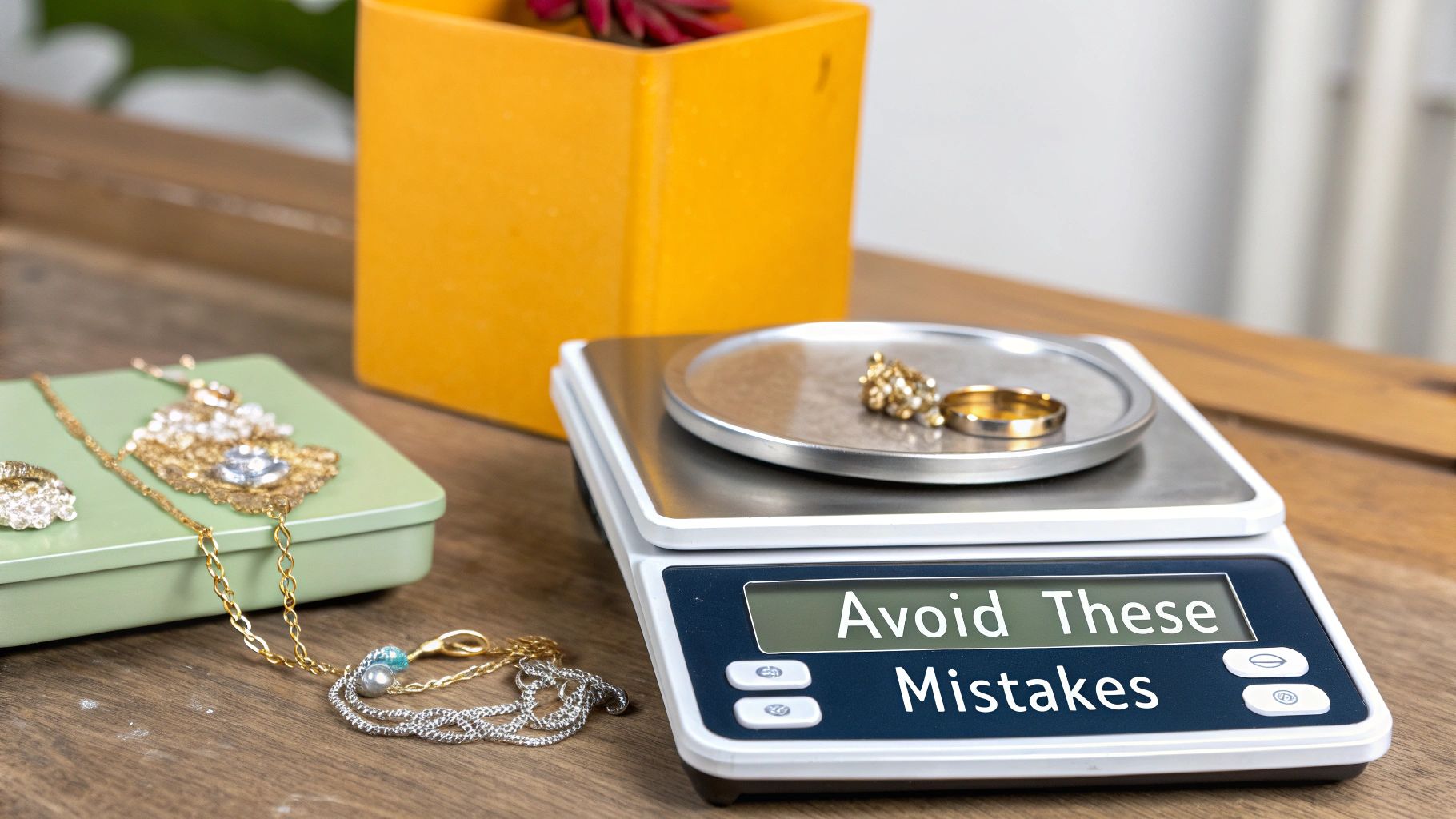
Knowledge is your best defense against a bad deal. While a gold scrap value calculator gives you a powerful head start, a few common mistakes can still trip you up and lead to a disappointing payout. Knowing what to watch out for is the key to selling your gold confidently and getting a fair price.
The most frequent error happens right at home before you even talk to a buyer: weighing your gold. Grabbing that old kitchen scale might feel convenient, but it can be surprisingly inaccurate. When you’re dealing with precious metals, every fraction of a gram matters, and a small miscalculation can have a big impact on the final value.
Inaccurate Measurements and Misidentifications
There’s a reason jewelers use professionally calibrated scales. If your home scale is off by even a few grams, your initial calculation will be flawed, setting you up with unrealistic expectations from the start. For the most accurate reading, always use a proper jeweler’s scale or have a trusted local jeweler weigh your items for you.
Another common slip up is misreading the karat markings. A faded or poorly stamped “14K” can easily be mistaken for “18K,” or you might confuse a gold plated piece with solid gold. It’s an easy mistake for an untrained eye to make, but it will dramatically throw off your estimate.
You also have to remember to account for anything that isn’t gold. So many jewelry pieces have components that add weight but have zero gold value.
- Gemstones: Diamonds, rubies, and other stones need to be removed or have their weight subtracted.
- Watch Movements: The complex internal machinery of a gold watch isn’t made of gold.
- Steel Springs: The clasps on necklaces and bracelets often contain tiny steel springs to make them more durable.
These little additions can add up, and if you don’t account for them, you’ll inflate your weight measurement and your initial valuation.
Understanding the Buyer’s Final Offer
This is probably the most critical part of the process: understanding the gap between your calculator’s estimate and a buyer’s final offer. The number you get from a gold scrap value calculator is the gross melt value the raw worth of the gold based on the live spot price. But a buyer will never pay this full amount.
Key Takeaway: A gold buyer’s offer will typically be 10% to 30% lower than the spot value. This deduction covers their costs for testing, melting, refining, overhead, and, of course, their profit margin.
This isn’t a scam; it’s just the business of buying gold. The global gold supply relies heavily on both new mining and robust recycling efforts. In fact, recycling activity recently strengthened, rising 6% year over year to 344 tonnes in a single quarter, which helped contribute to a record global supply. That recycled gold has to be processed, and buyers are the ones who manage that complex journey from scrap jewelry back to pure bullion.
To put it in perspective, here’s how a buyer’s payout might look for an item with a calculated gross value of $500.
| Buyer’s Payout Percentage | Deduction | Final Offer |
|---|---|---|
| 90% of Spot Value | $50 | $450 |
| 80% of Spot Value | $100 | $400 |
| 70% of Spot Value | $150 | $350 |
Seeing the numbers laid out like this prepares you for a realistic negotiation. It’s also vital to distinguish scrap gold from items that might have collectible value. This goes beyond just gold, too if you have other metallic items, knowing the best places to sell old coins can help you understand the difference between their numismatic value and their simple melt value.
By anticipating these deductions and accurately assessing your items, you can walk into the selling process with clarity and confidence.
A Few Final Questions About Gold Valuation
Even with a calculator in hand, you might still have a few lingering questions. That’s perfectly normal. Getting a clear and fair price for your gold means understanding a few details that pop up right at the end of the process. This section is here to give you quick, straightforward answers to the most common questions we hear from sellers.
Think of this as the last piece of the puzzle. Once these are answered, you’ll be able to walk into a sale feeling confident and fully prepared, with no surprises.
Where Can I Find Reliable Gold Spot Prices?
This is a fantastic question, since the entire valuation hinges on the live market price of gold. Your best bet for reliable, up to the minute gold spot prices is always a major financial news outlet or a reputable commodity market website. We’re talking about places like Bloomberg, Reuters, Kitco, and APMEX. These platforms get their data straight from the global commodity exchanges where gold is actually traded, like the COMEX.
Any trustworthy gold scrap value calculator will also pull this data in real time, often updating every few minutes to keep your estimate current. It’s always a smart move to cross reference the price a calculator shows with one of those major financial sites, just to be sure everything lines up.
Is There a Difference Between Grams and Pennyweights?
Yes, there is, and it’s a detail worth knowing. A gram (g) is the standard metric unit you’ll see used most often for weighing jewelry around the world. However, some jewelers, especially in North America, still use an older unit from the Troy system called a pennyweight (dwt).
Here’s the key conversion: one pennyweight is exactly 1.555 grams. While many modern digital scales can switch between units, the industry is mostly moving toward grams for simplicity and consistency. If you get a weight in pennyweights, a good online calculator can handle the conversion for you, but knowing the relationship between the two helps you understand exactly what you’re looking at.
Why Is a Buyer’s Offer Lower Than My Calculated Value?
This is easily the most common point of confusion for first time sellers, and it’s a great question. The number your gold scrap value calculator provides is the gross melt value that’s 100% of your gold’s market worth based purely on the spot price. A buyer’s offer, on the other hand, will be a percentage of that figure, usually somewhere between 75% and 95%.
This difference isn’t a scam; it’s just the reality of the gold recycling business. The buyer has to cover their own costs to take your scrap jewelry and turn it back into pure, refined gold bullion.
A buyer’s payout has to account for their business expenses. This includes the costs of testing, melting, refining, and transportation, not to mention their general overhead and a small profit margin to stay in business.
These costs are simply factored into their offer. For instance, if your gold’s calculated melt value is $1,000, a buyer offering 85% of the spot value would pay you $850. That $150 difference is what covers all their expenses for processing your gold.
Should I Wait for Gold Prices to Go Higher Before Selling?
Ah, the temptation to time the market! It’s a risky game. While it’s obviously true that selling when the spot price is high gets you more money, absolutely no one can predict with certainty whether prices will keep climbing or suddenly drop. Gold prices are swayed by incredibly complex global factors, from economic stability and inflation rates to geopolitical events.
A much saner approach is to sell when you need the cash or when the price feels fair to you based on your own financial goals. Trying to catch the absolute peak can be stressful and often doesn’t make a huge difference in the end. Instead of obsessing over market timing, focus on what you can control: getting an accurate weight, confirming your gold’s purity, and finding a reputable buyer who offers a fair percentage of the current spot value. That strategy ensures you get a solid return, no matter what the market is doing today.
Ready to discover the true value of your gold with a tool built for accuracy and transparency? The Gold Calculator provides free, real-time estimates based on live market data, updated every five minutes. Empower yourself with the knowledge to sell confidently.



